To security equipment, thus also to locks it particularly applies that most of us only pay attention to them after a harmful event occurs. Home, family, property and valuables are the most important in your life. Make sure you do not belong among the many people who have fallen victim of burglary. If you provide optimal protection for your doors and windows in time, burglars will look for easier targets.
To do this, you must spend on security products. This is not necessarily joyful, but do not forget, to spend on security is worth it. So you can have your assets, office, home or house safe and secure even when you are not there. Do not underestimate the risk, prevent the incident.
If possible, choose a certified security product and ask our colleagues for advice.
The more you know the preferred attack points and methods of burglars, the more you can defend against them. In the case of family houses, mostly the balcony doors and the windows, with condominiums, mainly the front doors are the weakest points. In addition to the entrance doors, terrace doors and windows, also garage doors, cellar windows and cellar doors pose a risk.
They are trying to lift front doors on the opening or hinge side, or drill, pull out or brake the cylinder lock in the door, or crush the door. They get in through windows or terrace doors by lifting them on the opening or the hinge side, by opening a partly open window, by pushing the shutter up, or by smashing the window glass; through cellar windows and doors, by sawing the bars, or forcing them open, or by lifting them on the opening or the hinge side.
Most burglars arrive with a set of opening tools and try out various opening techniques, just to get in. However, the more time goes by during a burglary or attempted breach, the greater the risk of being detected. So the burglars rarely take more than 3-5 minutes to gain access. If more time is required than this, there is a good chance they will give it up. Make sure to maximize the needed time of getting inside at you and that the good quality locks make the burglar's attempt as miserable as possible.
It is important to know that valuables cannot be completely protected. 100% protection can be strived for but rarely accomplished. Most security locks or accessories are capable to withstand a specific type of attack for a certain limited time. With some elements the opening is impossible with a certain technique, no matter how much time is spent on it. To pass through security devices however is a matter of time and a preparedness. If the attacker is competent enough and has the appropriate tools, it is only a question of time, before he can break through the line of defense.
This does not mean however that the mechanical security elements, such as locks, would not be useful. Their primary function is to hold up the attacker, to provide physical resistance. More sophisticated locks of higher quality and stronger structure ensure better resistance.
The level of security provided by a mechanical security element is also influenced by all the other elements. It is not worth to establish protection focusing only on one element. There is no point in having a high-end cylinder lock in the entrance door for example, if the structure of the door is weak. If e.g. the rest of the doors and windows are not or less protected, the burglar will go the easier way and make a move on those. Your valuables are more protected if you combine the security elements and select them in harmony to each other.
Mechanical security devices on their own are typically not sufficient to establish adequate protection, it is necessary to combine them with electronics. The most common form of this combination is connecting the mechanical security elements to an electronic indicator (alarm) system. Assault suffered by physical elements is detected by the signaling system and alarm is triggered. An alarm system working with a loud siren and a visual signal is a deterrent and awareness raising force on its own, but it provides much greater security if the alarm signal is sent to a patrol service also. Police or men of the security service arrive in these cases nearly always in time.
It is not always necessary to buy the best and most expensive locks. At selection, the required level of protection is an important aspect, you should choose accordingly. For a small locker where you do not store valuable items the cheapest padlock may be enough too, however, if you have valuables important to you in the room, you should choose a good quality lock.
If there are multiple lines of defense, in the first line the defense function has a much more significant role than in the second. If the points of entry into the premises are well protected, the inner doors' level of protection may be lower.
Answer the following questions to yourself and shed light on the easy to attack spots of your home. The more you are aware of the weak points burglars may use at you, the more you can protect yourself.
- Are the door fittings all fixed from the inside on every outer door and the cylinder lock is protected with a lid?
- Cylinder locks do not protrude more than 3 mm from the fitting on the outer side?
- Do you have a code card for your cylinder lock?
- Are the striking plates facing the mortise locks firmly fixed to the frame or wall?
- Is there an auxiliary lock on the locking (opening) side of your door?
- Is there an auxiliary lock on the hinge side of your door?
- Do you have the possibility to look out to check the visitor through a spy hole or with the use of a door chain or secondary lock, before opening the door fully?
- Do your windows have an auxiliary lock on the handle side from the basement to the attic?
- Do your windows have an auxiliary lock on the hinge side from the basement to the attic?
- Are the shutter protected against pushing?
- Do the horizontal bars have a special pull-up protection?
In case you have replied to any question with NO, please ask our colleague's advice how you could make your home more secure.
There are many options regarding your own behavior to reduce the risk of burglary. The most important are the following.
- Is the entrance area sufficiently illuminated?
- When you lock the front door while leaving, do you turn the key twice?
- Before you leave, do you make sure the windows and terrace doors are locked?
- When you moved in, did you replace the cylinder lock in the entrance door?
- Are there no equipment in the vicinity assisting the break-in (e.g. ladder)?
- Do you make sure that someone (e.g. your neighbor) is watching the property when you are not at home?
- Does your home insurance cover a sufficient amount in the event of damage, are your valuables not under-insured?
- Do you have an exact list of your valuables with photos?
If you have answered any of the questions with a NO, you should change your behavior and habits towards effective prevention of burglary.
Do not attempt to hold back the attacker yourself. Leave this task to the police (call 107). Make a note of the suspect's distinctive features, type of the car and the vehicle license plate number.
For choosing most of the locks, you have to know whether you are looking for a lock of a left- or right-hand door or window. To answer this question, proceed as follows.
As a rule of thumb for finding out the DIN-direction, you have to face the door from the side where the hinges are. This is the side towards which the door is opening.
If the hinges are to the left hand = DIN left, if the hinges are to the right hand = DIN right.
When ordering a bracket striking plate for a strike, you always have to provide information on the DIN-direction.
Main parts and most important sizes of mortise locks are illustrated in the following.
1) Face plate thickness
2) Face plate length
3) Face plate width
4) Lock case height
5) Lock case width
6) Lock case depth
7) Follower
8) Handle-key spindle Distance (D)
9) Backset (B)
10) Rear backset
11) Latch- and dead bolt distance
12) Bolt throw
The place of the mortise lock in a door is shown as follows.
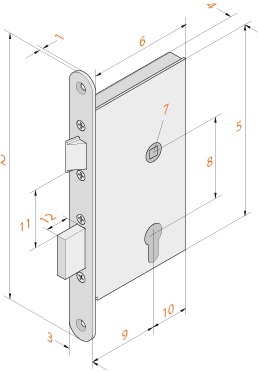
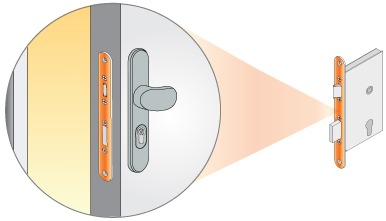
Main parts and most important sizes of cylinder locks are illustrated in the following.
1) Lock case height
2) Lock case width
3) Lock case depth (length)
4) Lock case outer length (L1)
5) Lock case inner length (L2)
6) Cam
7) Key hole
8) Hole of fastenting screw
The place of the cylinder lock in a door and the mortise lock is shown as follows.
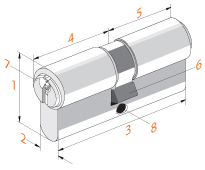
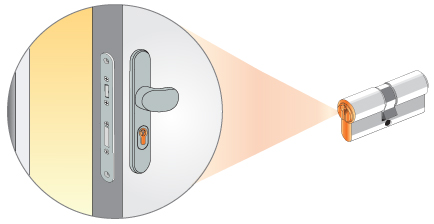
Main parts and most important sizes of padlocks are illustrated in the following.
1) Padlock case height
2) Padlock case width
3) Padlock case depth
4) Shackle height
5) Shackle thickness
6) Key hole
The place of the padlock on a door is shown as follows.
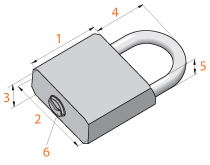
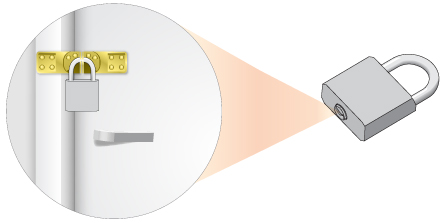
Main parts and most important sizes of shields are illustrated in the following.
1) Fastening screw
2) Handle
3) K-H spindle
4) Inner shield
5) Cylinder hole
6) Handle, knob
7) Outer shield
8) Cylinder lid
9) Drilling protection lid
The place of the fitting on a door is shown as follows.
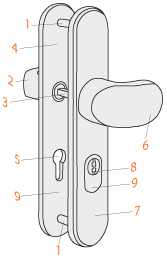
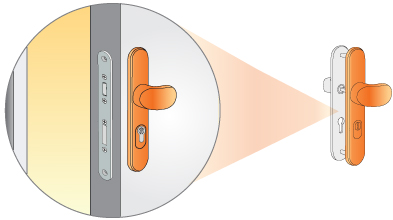
Main parts and most important sizes of strikes are illustrated in the following.
1) Lock case height
2) Lock case width
3) Lock case depth
4) Latch
5) Monitoring tile
6) Monitoring contacts
7) Fix fastening screws
8) FaFix fastening screws
The place of the strike in the door frame is shown as follows.
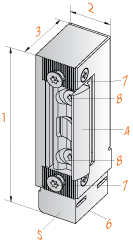
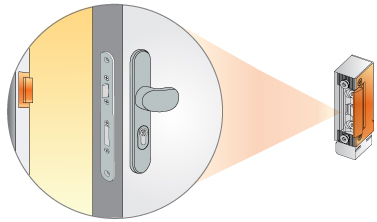







































 Product catalogue
Product catalogue